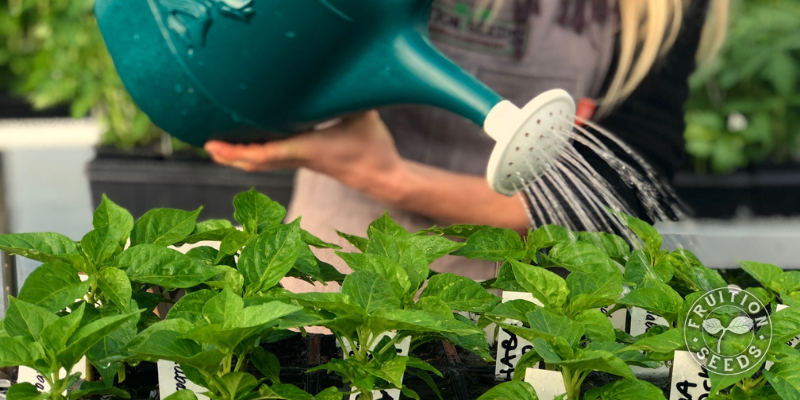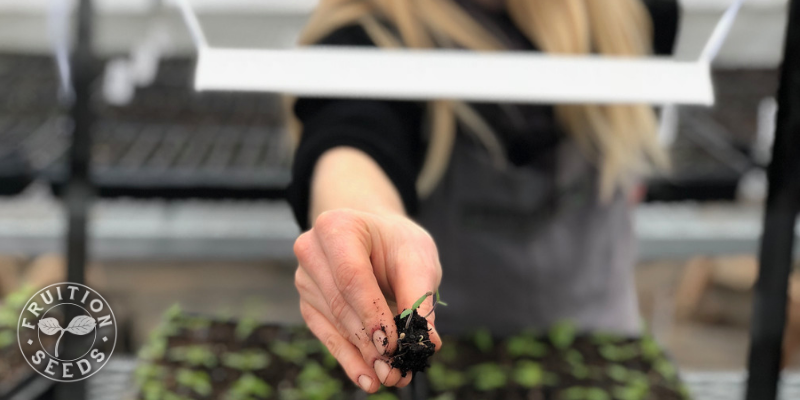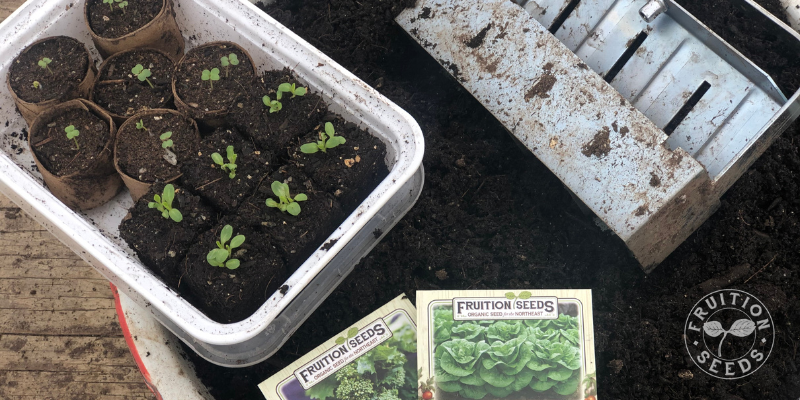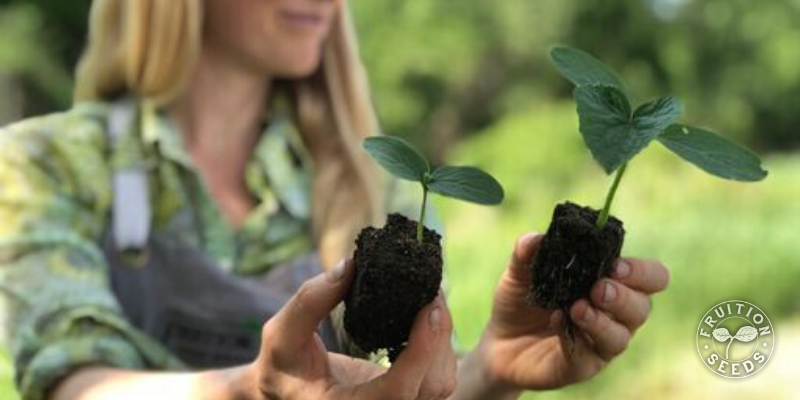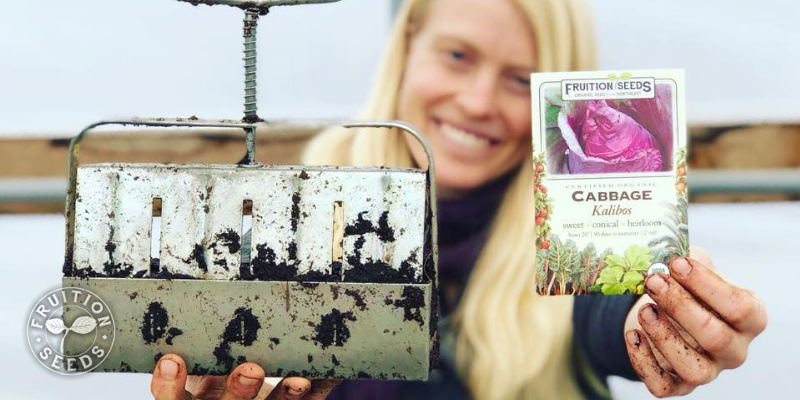You can start seeds in virtually anything that a) holds potting mix and b) drains excess water.
That being said, some containers are better than others.
Though creativity & resourcefulness are essential, now more than ever, it’s equally important to know the pros & cons of seed starting approaches.
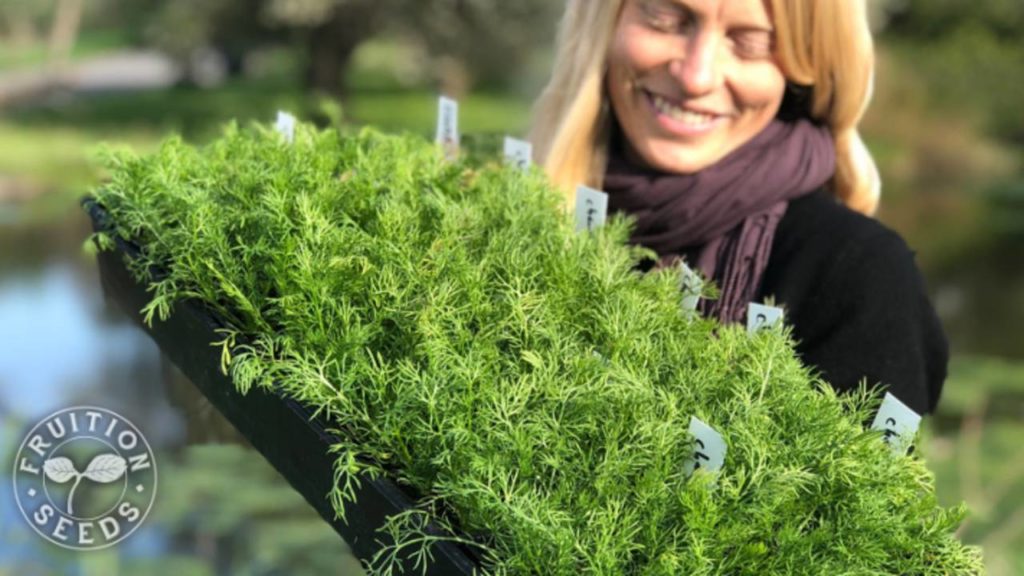
Starting seeds is such a joy…and it’s deceptively easy.
There are as many ways to garden as there are gardeners, but too many garden ‘hacks’ focus on the ‘wow!’ factor & not the fact that there are very real limitations as well as better approaches to consider.
I’ve already received hundreds of photos of struggling seedlings this spring, it’s simply not as easy as it seems. The worst ones by far are in egg cartons & jiffy pots — foreshadowing! — but don’t let me get ahead of myself!
Certainly, there are many variables. High-quality light & potting mix are key, as is not starting too soon (the classic pitfall!), but sowing in containers well-suited for you & your seedlings makes a world of difference.
High-quality light is often the biggest limiting factor to grow gorgeous tomato seedlings at home.
I love to emphasize what to do rather than what not to do, and most of this post is just that. Without further ado, I must say, after countless confirmations across decades of observation:
Egg cartons are for eggs.
Not for starting seeds.
They simply have too little soil to grow any seedling well without potting up; potting them up without disturbing their roots is not possible with their curvaceous sides. Can it be done? Of course! Would those plants be healthier in a bigger, better container? Every time!
If egg cartons are your absolute only option, you’ll find tips below to help you be more successful.
Just trust me, o please: egg cartons are for eggs.
Lots of other up-cycling approaches are better: toilet paper rolls are awesome! Take-out containers are genius! I’m all about re-framing resources & resourcefulness, as well as sharing all the insights you need to prevent unnecessary heartache 💛
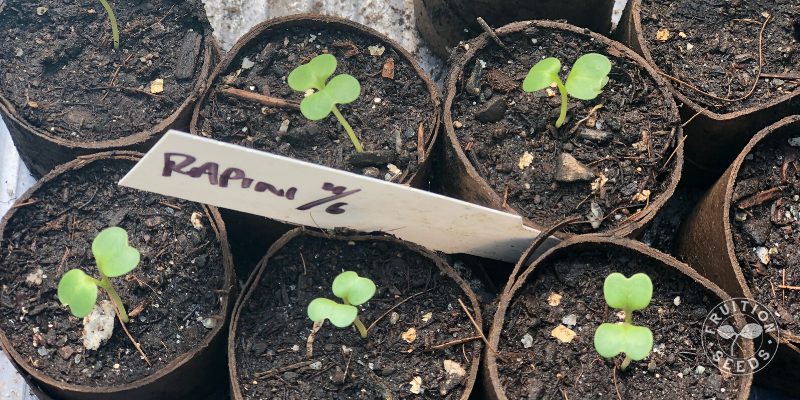
Toilet paper rolls are remarkably effective for starting quick-growing seeds you’ll transplant within 2 to 3 weeks, such as rapini, lettuce, kale and basil.
Keep in mind: If you’re starting seeds in your home, you’ll need a bottom tray to catch excess water from the containers that drain. When I was a girl, we used cookie sheets; plastic trays without holes are often available in garden centers, as well. Take -out containers are AMAZING! Poke holes every inch in a grid for your top tray and place a few pennies in each corner of the bottom tray so there is a touch of space allowing the top tray to still drain. Be creative and have fun!
Take-out containers make impressively effective trays for seedlings, especially soil blocks!
Here is a list of common containers people use for starting seeds, our general sentiments from decades of learning the hard way and easy solutions to common mistakes people have with them:
Containers we love, from best to less so…
Soil Blocks are the best! With the most nutrients and soil per volume and natural air-pruning, you won’t grow healthier transplants any other way plus you don’t have to use disposable plastic. Enjoy our blog x for the full story.
We sow most of our seeds in soil blocks, even cucurbits like these cucumbers who despise being transplanted, just to get ahead of the weeds. Avoid transplanting cucumbers, squash and melons, but if you do, make it a soil block or cow pot and transplant them young, as the left plant, rather than the right.
Common mistake: Blocks begin to crumble after a few days or weeks.
Easy Solution: Making solid blocks doesn’t just happen! With the right potting mix (we share both a compost-based mix and our DIY mix), diligence, honesty and experience, your soil blocks will be dense and glorious. If half of your potting mix is either coconut coir or peat moss, your mix will compress well while maintaining plenty of air space and lightness for root growth. For more tips, join our Seed Starting Academy (it’s now free!) and dive into Soil Blocking in 5 Easy Steps on our blog.
Soil blockers last years and often generations.
Peat/Cow Pots also prevent seeds from becoming root-bound and don’t engage disposable plastics. Cow pots are slightly more renewable than peat pots.
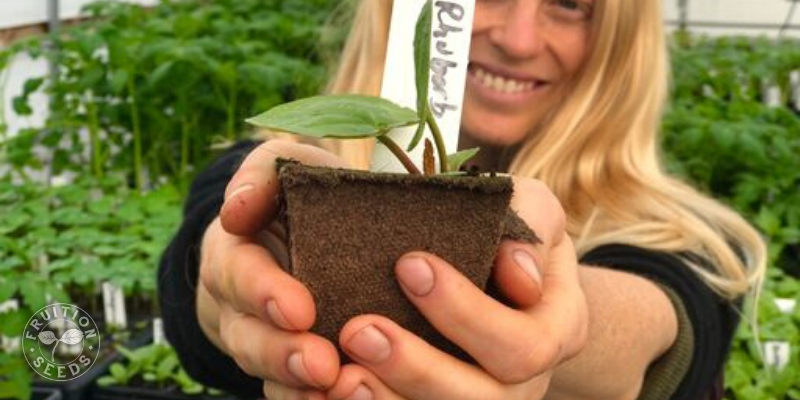
Cow pots are more renewable than peat pots.
Common mistake: Plants become root-bound in the house or in the garden.
Easy Solution: If peat pots dry out, they wick moisture away from the soil around them, effectively desiccating the plant roots around them. In the house, always keep your peat pots moist, ideally with bottom watering (page x). In the garden, be sure to plant your peat pot fully in the ground, so none of the peat pot is exposed to the air. Sometimes we’ll even tear off the top half-inch or so of the pot to ensure a delicate stem isn’t buried in soil and the edges of the pot are well below the soil surface.
Cell trays & 6-packs (larger cell sizes are better for most gardens)
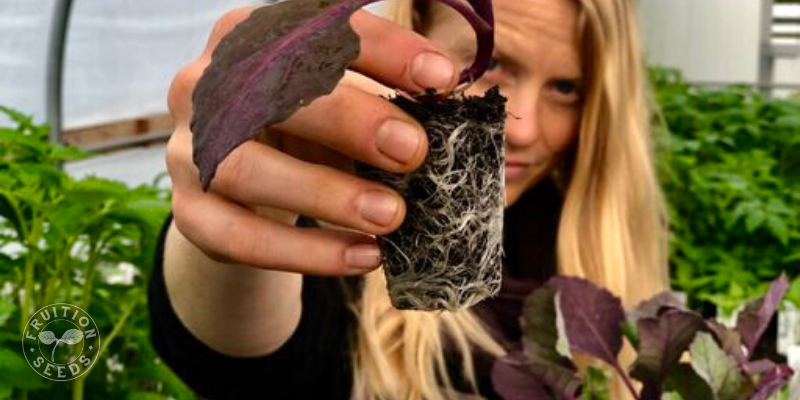
Seedlings can quickly become root-bound in cell trays. Some plants tolerate such stress better than others; transplant them as quick as you can to optimize their health.
Common mistake: It’s easy to sow seeds with air pockets in the soil below, so seedlings may grow evenly and/or transplant poorly. Also, seedlings can easily become root-bound. (This happens when their roots hit the edge of the container and try to find new soil as quickly as possible.)
Easy Solution: It’s really common for cell trays to have pockets of air among the potting mix. To ensure your cells are full of potting mix with no air pockets, fill your cell tray and then firmly — yet gently — tap your tray on the table. The potting mix will settle and add more potting mix to fill the trays fully. Voila!
To prevent your seedlings from becoming root-bound, plant them as soon as they’re ready to be planted either in your garden or ‘pot them up’ into a larger pot so they’ll continue to thrive.
Yogurt cups or Plastic Cups (½ cup volume) with at 4 to 6 ⅛-inch holes drilled in the bottom
Common mistake: Not drilling enough holes for water to effectively drain from the cup.
Easy Solution: When in doubt, drill a few more holes! It’s better to have more small holes than less large holes. Also, if the holes are too small, they might be clogged by particles in the potting mix; if they’re too large, your potting mix will simply fall through. Have fun finding the right balance for your potting mix!
Toilet paper rolls cut into one-inch pieces grow remarkably marvelous seed starting containers!
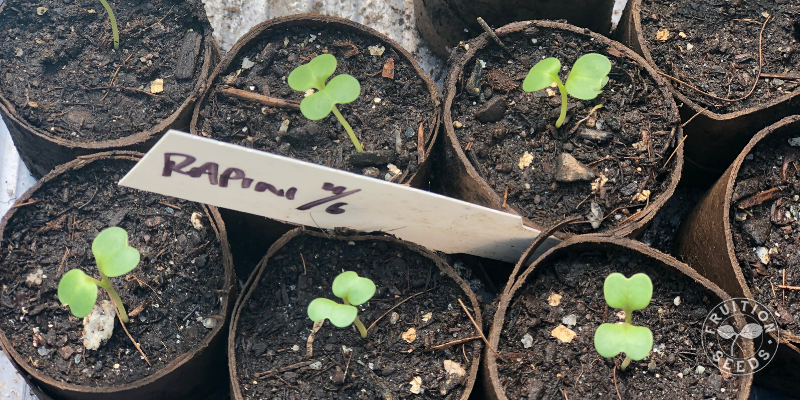
Be creative as you up-cycle your seed starting tools and techniques!
Common mistake: Keeping the rolls incessantly moist makes them prone to white mold and the adhesive readily dissolves. Also, planting the roll along with your seedling isn’t optimal.
Easy Solution:
Water only to top of the rolls, if you can, or let the cardboard dry out between waterings.
Also, only use paper pots for quick transplants less than four weeks old, like kale, zinnias and lettuce.
Finally, we recommend removing the plant gently from the toilet paper roll before transplanting. Though we’ve only just started experimenting with toilet paper rolls, they seem to maintain their structure much longer than sow or peat pots, constraining the root system of your transplant. Also, though I don’t know for sure, I could imagine there may well be chemicals in toilet paper rolls we’d prefer to not add to our gardens.
Paper Pots made from paper pot makers (it’s a sweet little British trick)
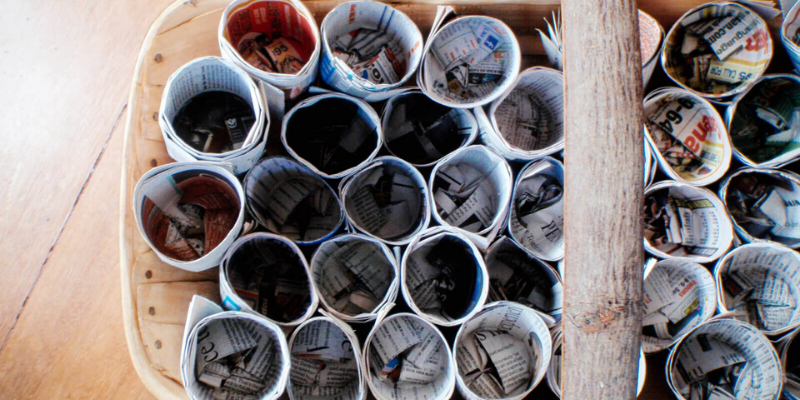
Paper pots share many of the advantages and disadvantages as toilet paper rolls. Let the paper dry out between waterings and only grow quick transplants like lettuce and zinnia in them.
Common mistake: Growing tomatoes or other 6+ week transplants in them…they just don’t hold up.
Easy Solution: Only use paper pots for quick transplants less than four weeks old, like kale, zinnias and lettuce.
Oh no!
These containers are all the worst…
Egg Cartons Defy Pinterest for your best interest! They simply have too little soil to grow any seedling well without potting up; potting them up without disturbing their roots is not possible with their curvaceous sides. Can it be done? Of course! Would those plants be healthier in a bigger, better container? Every time!
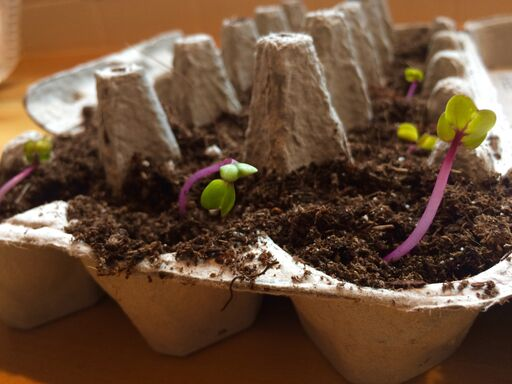
Egg cartons are for eggs! Not starting seeds.
If egg cartons are absolutely all you’ve got, your main challenge is this: There is no way to not grow a stressed seedling. Some seedlings tolerate less than optimal conditions better than others, so focus on those. Lettuce, kale, arugula, and basil will all bounce back, especially when potted up or transplanted young, as their first true leaves emerge.
Also, resist the temptation to plant your cardboard egg carton as cow or peat pots that decompose quickly when planted. They maintain their structure much longer, constraining the root system of your transplant. Plus, the dioxin, bleach and other chemicals in egg cartons you’d probably prefer to not add to your garden.
Yogurt Cups or Plastic Cups without holes. (Without drainage, your seedlings will drown/dampen off quickly.)
‘Peat Pellets,’ Jiffy Pots or other little containers of ‘potting mix’ in thin mesh expanding with water. (The potting mix they generally use is low quality and your seedlings will be hungry right away.)
There are as many ways to garden as there are gardens and seed starting is no exception! We’re constantly experimenting, learning new things, refining our approaches and taking notes so we can continue to do everything with more ease and joy in the seasons to come. We created our Across the Seasons perpetual calendar to make note-taking simple, effective and beautiful!
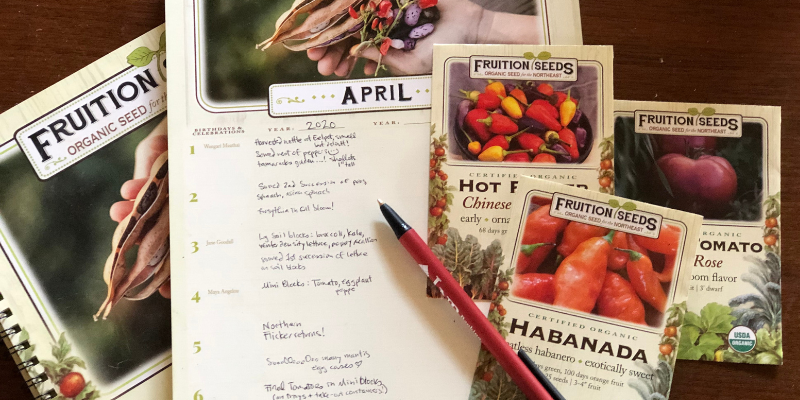
Take notes! Make them beautiful! It’s fun! You’ll learn so much! That’s why we made our Across the Seasons perpetual calendar!
I record what we’re sowing, when and how, as well as when the Red-Winged Blackbirds return, when the wild leeks are ready to harvest and everything else that happens in our gardens.
Happy Planting, Friends!
Sow Seeds & Sing Songs,

and the Many Beings of Fruition
ps
In so many ways, our gardens grow us more than we grow them! Pay attention to the ways your plants are adapting and know that we’re adapting all the time, as well!
